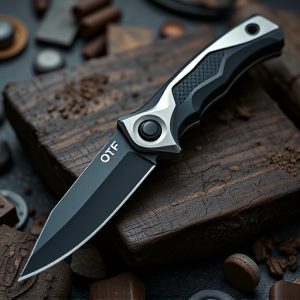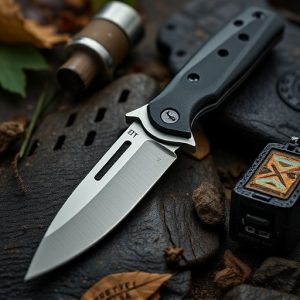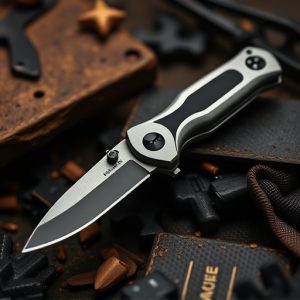Mastering the OTF Automatic Knife: A Comprehensive Guide
An OTF (Out-The-Front) automatic knife is a specialized folding knife known for its unique blade de…….
An OTF (Out-The-Front) automatic knife is a specialized folding knife known for its unique blade deployment mechanism where the blade extends forward with a spring-loaded system activated by pressing a lever or button. These knives are highly practical for immediate access to cutting tools, useful in everyday situations and coveted by collectors for their innovative designs. OTF knives feature safety mechanisms like a liner lock or ball-bearing lock and are ergonomically designed for both left- and right-handed users. They are ideal for discreet carry, offering rapid deployment and compactness. The legal status of these knives varies by jurisdiction, so it's crucial to comply with local laws. OTF automatic knives are appreciated for their blend of sleek aesthetics, practical utility, and cutting-edge technology, making them a must-have for enthusiasts and professionals. Owners should consider the durability and material quality of these knives for long-term use and understand that regular maintenance is necessary to maintain optimal performance.
Explore the intricate world of Out-the-Front, or OTF, automatic knives, a blend of precision engineering and practical utility. This article delves into the essence of these sleek, swift tools, detailing their functions, mechanisms, and the considerations for responsible ownership. Whether for tactical use, everyday carry, or as a collector’s item, understanding the OTF automatic knife phenomenon is key to appreciating its place in the modern toolkit. Join us as we unravel the features that set these knives apart and examine their practical applications across various fields.
Understanding the Front Knife: The OTF Automatic Knife Phenomenon
The term “OTF” stands for “Out the Front,” a designation for a type of automatic knife that has gained popularity among collectors, enthusiasts, and professionals alike. These knives are characterized by their blade, which extends out from the handle in a smooth motion when deployed, often at the push or flip of a button or switch. The mechanics behind an OTF automatic knife involve an internal spring-loaded system that counterbalances the weight of the blade, allowing it to open with minimal effort and return to the closed position with equal ease. This seamless deployment makes the OTF a practical tool for rapid deployment in situations where quick access to a cutting edge is necessary.
When considering the appeal of an OTF automatic knife, it’s important to examine both its functionality and the versatility it offers. These knives are not only functional for everyday tasks like cutting rope or opening packages but also serve as a testament to engineering ingenuity. The OTF mechanism is subject to strict regulations in many jurisdictions due to its automatic nature, which can be both a defense mechanism and a challenge for those who appreciate the design and performance of these knives. Collectors often seek out OTF automatic knives for their unique designs, innovative deployments, and the challenge they present in maintaining legality and functionality. Whether used for utilitarian purposes or as a collector’s item, the OTF automatic knife remains a subject of fascination and discussion within the knife community.
Features and Mechanisms of Out-the-Front (OTF) Automatic Knives
Out-the-Front, commonly known as OTF, automatic knives are a category of folding knives that feature a distinctive mechanism allowing the blade to extend out of the handle in a linear motion. This unique design sets them apart from traditional sliding or lockback folding knives. The OTF automatic knife is engineered with an internal spring-loaded system housed within the handle, which propels the blade forward at the user’s command. The activation of this mechanism is typically controlled by a lever or button, usually located on the handle’s side or near the spine of the knife.
Upon deployment, the blade lock secures the blade in an open position, ensuring safety and functionality. The lock, often a liner lock or a ball-bearing lock, engages as the blade moves out and prevents accidental closure under normal use. This feature is crucial for both user security and task efficiency, making OTF automatic knives suitable for various applications, from outdoor survival to tactical situations. The sleek design of these knives often includes an ambidextrous nature, making them accessible to left- and right-handed users alike. The OTF knife’s speed and ease of deployment are matched only by its compactness when closed, allowing for discreet carry and convenient access in a pinch. The balance of form and function in these knives makes them a sought-after tool among collectors and professionals who value innovation and efficiency in their cutting instruments.
Practical Applications and Considerations for Owning an OTF Automatic Knife
An OTF, or Out-The-Front automatic knife, offers a unique blend of functionality and convenience that sets it apart from traditional folding knives. The practical applications for an OTF knife are vast, ranging from everyday carry to specific professional uses. For individuals who engage in activities such as outdoor adventuring, hunting, or fishing, the one-handed opening feature of an OTF knife can be particularly beneficial, allowing users to stay prepared without fumbling with complex mechanisms. In situations where rapid deployment of a blade is necessary, the OTF automatic knife excels due to its swift and seamless motion.
Owning an OTF automatic knife also requires careful consideration of legal restrictions, as not all jurisdictions permit their carry or use. It’s crucial to be well-versed in local laws regarding automated knives, as violations can lead to serious consequences. Additionally, safety is paramount when handling such a tool; users must ensure they are familiar with the knife’s operation to prevent unintended deployment or injury. Maintenance becomes a critical aspect too, as the moving parts of an OTF knife necessitate regular cleaning and lubrication to maintain optimal performance. Prospective owners should also consider the knife’s durability, the quality of its materials, and its ergonomic design to ensure it meets their specific needs and withstands the intended use over time.


